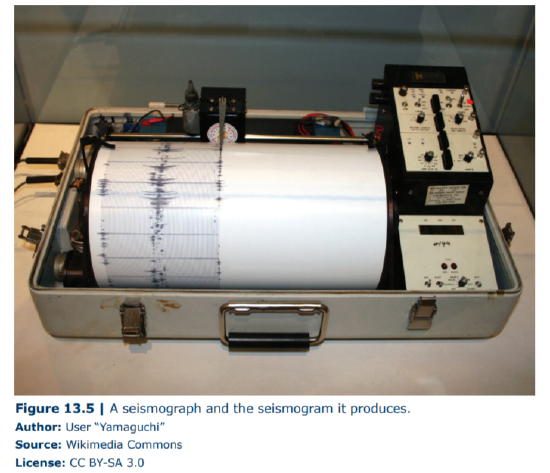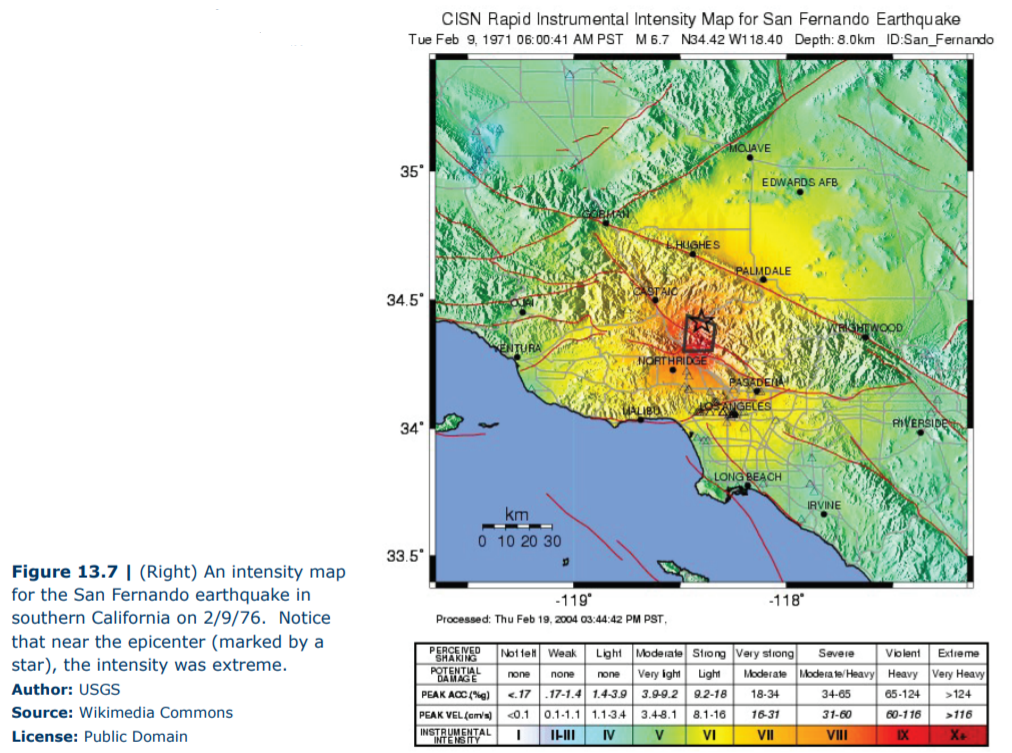13.3: Seismology
- Page ID
- 5687
\( \newcommand{\vecs}[1]{\overset { \scriptstyle \rightharpoonup} {\mathbf{#1}} } \)
\( \newcommand{\vecd}[1]{\overset{-\!-\!\rightharpoonup}{\vphantom{a}\smash {#1}}} \)
\( \newcommand{\id}{\mathrm{id}}\) \( \newcommand{\Span}{\mathrm{span}}\)
( \newcommand{\kernel}{\mathrm{null}\,}\) \( \newcommand{\range}{\mathrm{range}\,}\)
\( \newcommand{\RealPart}{\mathrm{Re}}\) \( \newcommand{\ImaginaryPart}{\mathrm{Im}}\)
\( \newcommand{\Argument}{\mathrm{Arg}}\) \( \newcommand{\norm}[1]{\| #1 \|}\)
\( \newcommand{\inner}[2]{\langle #1, #2 \rangle}\)
\( \newcommand{\Span}{\mathrm{span}}\)
\( \newcommand{\id}{\mathrm{id}}\)
\( \newcommand{\Span}{\mathrm{span}}\)
\( \newcommand{\kernel}{\mathrm{null}\,}\)
\( \newcommand{\range}{\mathrm{range}\,}\)
\( \newcommand{\RealPart}{\mathrm{Re}}\)
\( \newcommand{\ImaginaryPart}{\mathrm{Im}}\)
\( \newcommand{\Argument}{\mathrm{Arg}}\)
\( \newcommand{\norm}[1]{\| #1 \|}\)
\( \newcommand{\inner}[2]{\langle #1, #2 \rangle}\)
\( \newcommand{\Span}{\mathrm{span}}\) \( \newcommand{\AA}{\unicode[.8,0]{x212B}}\)
\( \newcommand{\vectorA}[1]{\vec{#1}} % arrow\)
\( \newcommand{\vectorAt}[1]{\vec{\text{#1}}} % arrow\)
\( \newcommand{\vectorB}[1]{\overset { \scriptstyle \rightharpoonup} {\mathbf{#1}} } \)
\( \newcommand{\vectorC}[1]{\textbf{#1}} \)
\( \newcommand{\vectorD}[1]{\overrightarrow{#1}} \)
\( \newcommand{\vectorDt}[1]{\overrightarrow{\text{#1}}} \)
\( \newcommand{\vectE}[1]{\overset{-\!-\!\rightharpoonup}{\vphantom{a}\smash{\mathbf {#1}}}} \)
\( \newcommand{\vecs}[1]{\overset { \scriptstyle \rightharpoonup} {\mathbf{#1}} } \)
\( \newcommand{\vecd}[1]{\overset{-\!-\!\rightharpoonup}{\vphantom{a}\smash {#1}}} \)
\(\newcommand{\avec}{\mathbf a}\) \(\newcommand{\bvec}{\mathbf b}\) \(\newcommand{\cvec}{\mathbf c}\) \(\newcommand{\dvec}{\mathbf d}\) \(\newcommand{\dtil}{\widetilde{\mathbf d}}\) \(\newcommand{\evec}{\mathbf e}\) \(\newcommand{\fvec}{\mathbf f}\) \(\newcommand{\nvec}{\mathbf n}\) \(\newcommand{\pvec}{\mathbf p}\) \(\newcommand{\qvec}{\mathbf q}\) \(\newcommand{\svec}{\mathbf s}\) \(\newcommand{\tvec}{\mathbf t}\) \(\newcommand{\uvec}{\mathbf u}\) \(\newcommand{\vvec}{\mathbf v}\) \(\newcommand{\wvec}{\mathbf w}\) \(\newcommand{\xvec}{\mathbf x}\) \(\newcommand{\yvec}{\mathbf y}\) \(\newcommand{\zvec}{\mathbf z}\) \(\newcommand{\rvec}{\mathbf r}\) \(\newcommand{\mvec}{\mathbf m}\) \(\newcommand{\zerovec}{\mathbf 0}\) \(\newcommand{\onevec}{\mathbf 1}\) \(\newcommand{\real}{\mathbb R}\) \(\newcommand{\twovec}[2]{\left[\begin{array}{r}#1 \\ #2 \end{array}\right]}\) \(\newcommand{\ctwovec}[2]{\left[\begin{array}{c}#1 \\ #2 \end{array}\right]}\) \(\newcommand{\threevec}[3]{\left[\begin{array}{r}#1 \\ #2 \\ #3 \end{array}\right]}\) \(\newcommand{\cthreevec}[3]{\left[\begin{array}{c}#1 \\ #2 \\ #3 \end{array}\right]}\) \(\newcommand{\fourvec}[4]{\left[\begin{array}{r}#1 \\ #2 \\ #3 \\ #4 \end{array}\right]}\) \(\newcommand{\cfourvec}[4]{\left[\begin{array}{c}#1 \\ #2 \\ #3 \\ #4 \end{array}\right]}\) \(\newcommand{\fivevec}[5]{\left[\begin{array}{r}#1 \\ #2 \\ #3 \\ #4 \\ #5 \\ \end{array}\right]}\) \(\newcommand{\cfivevec}[5]{\left[\begin{array}{c}#1 \\ #2 \\ #3 \\ #4 \\ #5 \\ \end{array}\right]}\) \(\newcommand{\mattwo}[4]{\left[\begin{array}{rr}#1 \amp #2 \\ #3 \amp #4 \\ \end{array}\right]}\) \(\newcommand{\laspan}[1]{\text{Span}\{#1\}}\) \(\newcommand{\bcal}{\cal B}\) \(\newcommand{\ccal}{\cal C}\) \(\newcommand{\scal}{\cal S}\) \(\newcommand{\wcal}{\cal W}\) \(\newcommand{\ecal}{\cal E}\) \(\newcommand{\coords}[2]{\left\{#1\right\}_{#2}}\) \(\newcommand{\gray}[1]{\color{gray}{#1}}\) \(\newcommand{\lgray}[1]{\color{lightgray}{#1}}\) \(\newcommand{\rank}{\operatorname{rank}}\) \(\newcommand{\row}{\text{Row}}\) \(\newcommand{\col}{\text{Col}}\) \(\renewcommand{\row}{\text{Row}}\) \(\newcommand{\nul}{\text{Nul}}\) \(\newcommand{\var}{\text{Var}}\) \(\newcommand{\corr}{\text{corr}}\) \(\newcommand{\len}[1]{\left|#1\right|}\) \(\newcommand{\bbar}{\overline{\bvec}}\) \(\newcommand{\bhat}{\widehat{\bvec}}\) \(\newcommand{\bperp}{\bvec^\perp}\) \(\newcommand{\xhat}{\widehat{\xvec}}\) \(\newcommand{\vhat}{\widehat{\vvec}}\) \(\newcommand{\uhat}{\widehat{\uvec}}\) \(\newcommand{\what}{\widehat{\wvec}}\) \(\newcommand{\Sighat}{\widehat{\Sigma}}\) \(\newcommand{\lt}{<}\) \(\newcommand{\gt}{>}\) \(\newcommand{\amp}{&}\) \(\definecolor{fillinmathshade}{gray}{0.9}\)Overview
Earthquakes have been experienced by humans as long as humans have roamed the Earth, though most ancient cultures developed myths to explain them (including envisioning large creatures within the Earth that were moving to create the quake). The study of earthquakes, called seismology, began to take off with the development of instruments that can detect earthquakes; this instrument, called a seismograph, can measure the slightest of Earth’s vibrations (Figure 13.5). A typical seismograph consists of a mass suspended on a string from a frame that moves as the Earth’s surface moves. A rotating drum is attached to the frame and a pen attached to the mass so that the relative motion is recorded in a seismogram. It is the frame (attached to the ground) that moves during an earthquake—the suspended mass generally stays still due to inertia (the tendency of a body to stay at rest and resist movement).

How Are Earthquakes Measured?
The tragic consequences of earthquakes can be measured in many ways, like death tolls or force of ground shaking. Two measures, in particular, are commonly used. One is a qualitative measure of the damage inflicted by the earthquake, and it is referred to as intensity. The second is a quantitative measure of the energy released by the earthquake, termed magnitude. Both measures provide meaningful data.
Earthquake Intensity
Intensity measurements take into account both the damage incurred due to the quake and the way that people respond to it. The Modified Mercalli Intensity Scale (Figure 13.6) is the most widely used scale to measure earthquake intensities. This scale has values that range from Roman numerals I to XII which characterize the damage observed and people’s reactions to it. Data for this scale is often collected right after an earthquake by having the local population answer questions about the damage they see and what happened during the quake. This information can then be pooled to create an intensity map, which creates colored zones based on the information collected (Figure 13.7). These maps are frequently used by the insurance industry.
| Intensity | Characteristics |
| I | Shaking not felt under normal circumstances. |
| II | Shaking felt only by those at rest, mostly along upper floors in buildings. |
| III | Weak shaking felt noticeably by people indoors. Many do not recognize this as an earthquake. Vibrations similar to a large vehicle passing by. |
| IV | Light shaking felt indoors by many, outside by few. At night, some were awakened. Dishes, doors, and windows disturbed; walls cracked. Sensation like a heavy truck hitting a building. Cars rock noticeably. |
| V | Moderate shaking felt by most; many awakened. Some dishes and windows will be broken. Unstable objects overturned. |
| VI | Strong shaking felt by all, with many frightened. Heavy furniture may move, and plaster breaks. Damage is slight. |
| VII | Very strong shaking sends all outdoors. Well-designed buildings sustain minimal damage; slight-moderate damage in ordinary buildings; considerable damage in poorly built structures. |
| VIII | Severe shaking. Well-designed buildings sustain slight damage; considerable damage in ordinary buildings; great damage in poorly built structures. |
| IX | Violent shaking. Well-designed buildings sustain considerable damage; buildings are shifted off foundations, with some partial collapse. Underground pipes are broken. |
| X | Extreme shaking. Some well-built wooden structures are destroyed; most masonry and frame structures are destroyed. Landslides considerable. |
| XI | Few structures are left standing. Bridges are destroyed, and large cracks open in the ground. |
| XII | Total damage. Objects thrown upward in the air. |

Earthquake Magnitude
Another way to classify an earthquake is by the energy released during the event; this is referred to as the magnitude of the earthquake. While magnitude has been measured using the Richter scale, as the frequency of earthquake measurements around the world increased, it was realized that the Richter magnitude scale was not valid for all earthquakes (it is not accurate for large magnitude earthquakes). A new scale called the Moment Magnitude Intensity Scale was developed, which maintains a similar scale to the Richter scale. This scale estimates the total energy released by an earthquake and can be used to characterize earthquakes of all sizes throughout the world. The magnitude is based on the seismic moment (estimated based on ground motions recorded on a seismogram), which is a product of the distance a fault moved and the force required to move it. This scale works particularly well with larger earthquakes and has been adopted by the United States Geological Survey. Magnitude is based on a logarithmic scale, which means for each whole number that you increase, the amplitude of the ground motion recorded by a seismograph increases by 10 and the energy released increases by 101.5, rather than one (so that a 3 magnitude quake results in ten times the ground shaking as a 2 magnitude quake; a magnitude 4 quake has 102 or 100 times the level of ground shaking as a 2 magnitude quake (releasing 103 or 1000 times as much energy). For a rough comparison of magnitude scale to intensity, see Figure 13.8. Why is it necessary to have more than one type of scale? The magnitude scale allows for worldwide characterization of any earthquake event, while the intensity scale does not. With an intensity scale, an IV in one location could be ranked a II or III in another location, based off of building construction (ex. poorly constructed buildings will suffer more damage in the same magnitude earthquake as those built with stronger construction).
| Table of Comparison of Magnitude versus Intensity Scales for Earthquakes |
| Magnitude | Typical Maximum Modified Mercalli Intensity |
| 1.0-2.9 | I |
| 3.0-3.9 | II-III |
| 4.0-4.9 | IV-V |
| 5.0-5.9 | VI-VII |
| 6.0-6.9 | VIII-IX |
| 7.0 and above | X or above |


